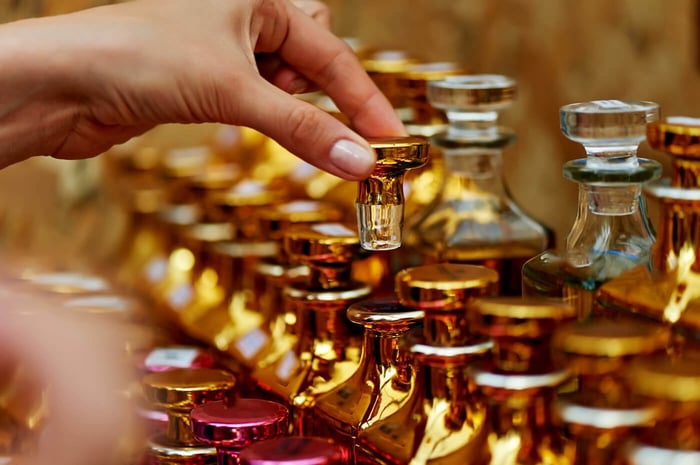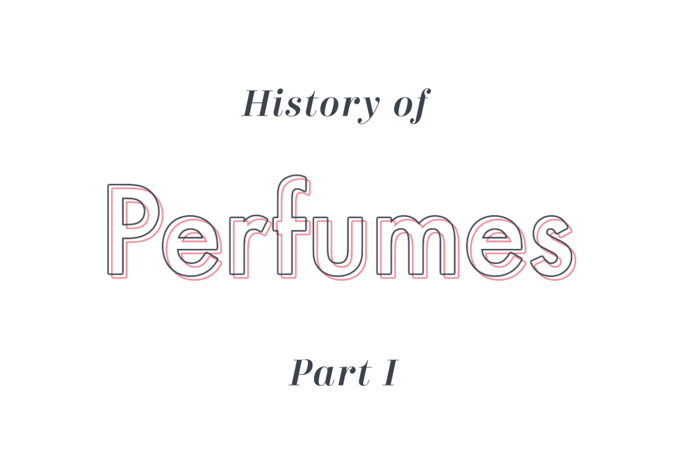Shopping for new perfume can be overwhelming and a tricky business with all the scents available today. However, it gets even more complicated when there are different versions of the same scent available. Extraits to Colognes to Aftershaves, there are countless options of fragrances available in the market and at least a thousand new fragrances are launched every year. Finding the right concentration is just as important as choosing the right fragrance. Many people get anxious & confused when the salesperson asks “Which concentration would you prefer?”
Fragrance concentration refers to the strength or quantity of perfume oil that a fragrance has. Higher perfume oil concentration generally means stronger fragrance, greater longevity on the skin, and also a higher price point.
Fragrance concentrations are broken down into the following easy-to-understand categories, these are of general nature rather than a specific one. So we would suggest you take it all with some salt:-
Parfum - The word Parfum comes from the Latin phrase per- (through, thoroughly) + fumäre (to smoke), also known as Pure Perfume or Extrait de Perfume. This is the purest, concentrated, expensive, and long-lasting of all fragrance concentrations.
On average, it contains anywhere from 15% all the way up to 40% perfume essential oils (IFRA: typical 20%) and due to its higher concentration of fragrance oil one can expect Parfum to last at least 8 hours and far beyond.
Extrait de Parfum may feel a bit heady at the beginning due to its concentration but it gives the wearer a full spectrum of Top, Heart and Base notes that are released slowly over time. Alcohol composition in Parfum is the lowest among all other concentrations, which makes it an excellent choice for those with sensitive-dry skin as it tends to stay on the surface and is less likely to dry out the pores.
It usually comes in small but heavy glass flacon bottles typically consisting of anywhere from 7.5ml to 30ml with ornate stoppers and is generally dabbed on certain pulse points and isn't used all over the body. However, the trend today is that even Parfum versions come in 50 or 100ml bottles with sprayers.
At the beginning of Modern Western Perfumery, this was the most usual format offered in perfume houses. It is believed that Jicky by Aime Guerlain, an oriental Fougere fragrance for women, is the first fragrance labeled as "Parfum" in 1889.
Eau de Parfum- After Parfum, Eau de Parfum also known as EDP occupies the next spot when it comes to strength and concentration. Many confuse Eau de Parfum with Pure Parfum, however, the keyword here is "Eau" meaning "from water" which means essence is more dissolved & diluted. Eau de Parfum usually offers a concentration between 10-20%. On average, Eau de Parfum will last for a solid 6 to 8 hours.
As the oil level drops, there is more alcohol added, thus making it generally cheaper than pure Parfum but still, EdP remains among the higher end of the price spectrum. Whilst Parfum concentration gives the wearer the full blend of Top, Heart, and Base Notes, Eau de Parfum focuses on the Heart notes as the Top Notes vanishes from the skin quicker.
This EDP version is very common and a popular option for its slightly lower price but luxurious feel, making it the best of both worlds. Since it is one of the most popular categories, most brands start off their fragrances in this concentration. EDP concentration is also referred to as “Millesime”, a term famously used by the house Creed.
Eau de Toilette - The term Eau de Toilette comes from the French term "faire sa toilette" which means "getting ready". It was the cleaning water that was used to be added in the bathing water or applied directly onto the body after bathing. Due to which in this context Eau de Toilette also means ‘Grooming Water” or “Toilet Water”.
Modern perfumery adopted the term to indicate the concentration of a fragrance. EDT was first produced in the 14th century. It is a light watered-down composition of EDP and designed for individuals looking for the same scent but a subtle & delicate option.
The oil concentration in EDT generally varies from 5% to 15%. EDT can maintain its pleasant scent anywhere from 4 to 6 hours per application (depending on the skin).
This type has better projection due to higher alcohol concentration which makes it radiate and diffuse from your body for longer distance. For many people, it is a go-to choice for a typical day.
Some prefer EDT for the day, due to the abundance of hesperidic citrus notes. It is a great choice to create first impressions as it has a generous dose of alcohol that can create an aura of scented bubble around you.
The majority of perfume brands offer their scents in EDT concentrations allowing people to enjoy their creations without burning a hole in the pocket.
Eau de Cologne - Eau de Cologne, EDC or simply Cologne, usually has a 2% to 4% concentration of the perfume and an excessive amount of alcohol. Lasting power drops to somewhere around 2 to 4 hours, making it an extremely light and inexpensive liquid. These products are generally used to neutralize body stench or are used as a Splash-on fragrance.
Eau de Cologne is arguably the oldest type of perfume concentration used. It is translated from French as "water of cologne".
In 1709, Italian barber Giovanni Maria-Farina devised a concoction, which he named Kölnisch Wasser (Cologne Water) after its hometown Köln in Germany. It was highly praised by Emperor Napoleon, who used it not only as a perfume but also for gargling, drinking and taking a bath.
Eau de Cologne is a generic term for perfumes geared for male usage but there are still plenty of female perfumes which use this designation. Typically, many EDCs are formulated for Men as lighter fragrance variation of its EDP or EDT counterpart.
Eau de Cologne originally referred to a traditional chypre recipe that used heavy quantities of Top notes of citruses and tiny base of herbal notes. Thus, EDC gives a citrusy, airy, light and fresh feel.
EDC concentrations have a variety of uses, like, dabbing some on sensitive skins, using it to scent a handkerchief or simple spraying this to take in the calm, pleasant aroma. Also, EDC needs to be applied in generous doses, as a result of which EDCs are often available in large size bottles of volume up to 200 ml and spraying is usually the application method. One of the oldest colognes 4711 developed by Wilhelm Mülhers (or Maurer and Wirtz) in the 18th century, is still produced and worn today, a true classical masterpiece.
There are some perfumes that are marketed as EDC but give outperformance that is comparable to many EDTs or EDPs out there due to the fixatives or base compounds used to enhance the longevity of the scent.
Having covered the most known types of perfume concentrations there are some left that do not generally get the popularity they deserve i.e. after shave Lotions & Body Mists.
One could argue that there is virtually no difference between EDC, Aftershaves & Body Mists since they all have roughly the same amount of perfume concentrations. However, the difference mainly lies in the composition & intended use of all three.
After Shave - The earliest known example of humans shaving is at least 100,000 years old when stone-age men used seashells to pick out their beards (Ouch!). But shaving as we know it goes back to at least 60,000 years.
Since the tools that they used instead of a Razor were dull, a shave in those times usually resulted in bruises and cuts. Which were bound to get infected due to the hygiene conditions in those times. To overcome this health hazard, people all around the world soon started using water, Alum, Alcohol, and much later, Ethanol.
The primary tool which acted as a razor has since developed during the years. However, the use of a liquid to sanitize the cuts has been a constant forever (cause let's face it, some men are clumsy and will end up cutting themselves, or God forbid, others!).
During the popularity of the use of ethanol, some men with a brilliant idea mixed perfumed compounds in the ethanol mixture to give birth to the aftershave lotions we use today.
Where Eau De Cologne can be naively termed as a light perfume. After Shave lotion’s primary purpose is to disinfect the skin after its close encounter with a sharp razor and a secondary purpose to leave you with a pleasant fragrance.
In the current market, there is a head-scratching number of options while choosing to buy and Aftershave, some even claim to make you look younger. Despite the absurd claims, Aftershaves have been used since time immemorial & is a trend that is here to stay.
Body mists - Body mists are based around a water & ethanol formula. Which includes a fragrant compound to give you that light aura around you and is only noticeable to people who get intimately close to you.
Mostly they are used after taking a bath, however, they are also now increasingly used as a part of a nighttime routine, where you just want a light scent to calm your sense and bring you to sleep.
When it was released it was intended to be used by teenagers going to school, however, over the years it has started to be used by almost everyone.
Body Mists have a very low perfume concentration. Which results in a light fragrance (perfect for people who dislike strong scents) giving one a performance of 2-3 hours. It is different from its other low concentration counterparts as it is mostly based on a water & ethanol-derived formula and hydrates your skin as well as giving you a mild scent to enjoy.
They are also pretty useful when layering a certain fragrance. You can layer the Body Mist with body butter or can layer a perfume with the same brand’s body mist.






